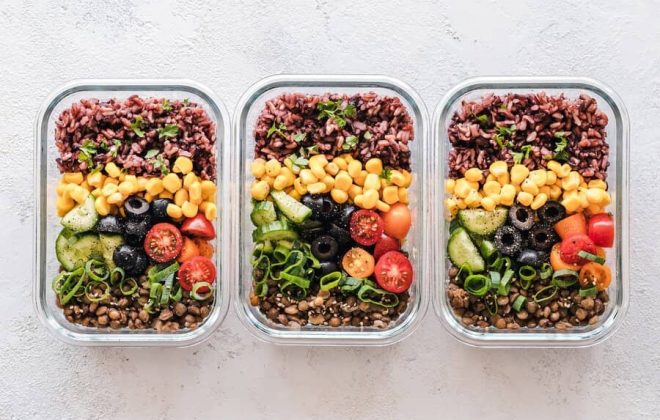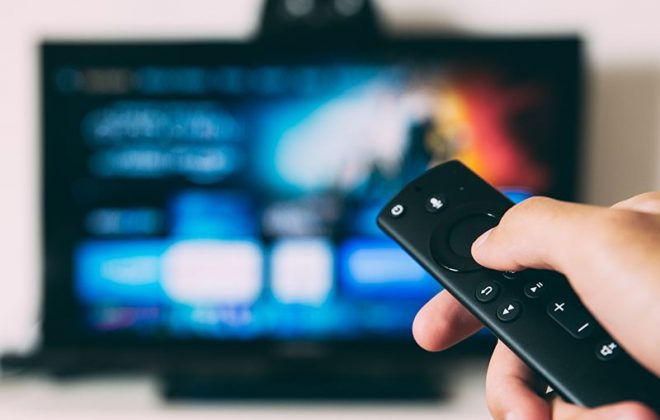Endurance Race Nutrition Strategies – How To Fuel For Top Performance
Nutrition is a complex area which is why many athletes overlook it. It took me years to notice the difference various foods make even on the training process – let alone the race result. But that’s where the endurance race nutrition guide below has started.
I learned the hard way how nutrition can either support the body to produce maximum performance or work against and slow it down. All that experience from my trials & errors and the research I did is summarized below.
I publish this guide to have a reference for myself for future races, as well as help others prepare their endurance race nutrition strategies.
Scroll down to learn what makes a good endurance race nutrition plan. Scroll to the bottom for actual race nutrition strategies.
Endurance race nutrition plan
Endurance racing takes time and requires a great deal of patience. You can’t just hammer it out from the start during a half marathon and hold on for dear life. Athletes need a race plan and pace themselves carefully to make sure energy is used as efficiently as possible.
The same principle applies to nutrition. Our body’s reserves are not infinite, so any opportunity we can have to replenish them goes a long way. The longer the race the bigger the impact that improper fueling has on the body.
Endurance race nutrition plan should consider which nutrition to take and at what intervals. That will give athletes the structure and consistency required in a long distance race.
Endurance race nutrition – hydration
The most important part of a nutrition plan is hydration. Adequate fluid intake is critical when you’re physically active.
Sweating is the body’s natural cooling mechanism. Athletes lose a lot of water and minerals through sweat, which is why it’s important to replace that.
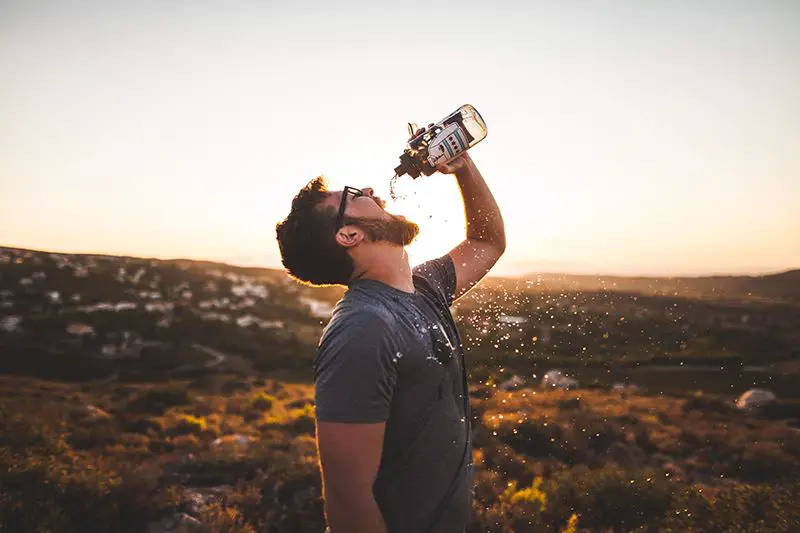
It’s best to consume fluids in small amounts every 10-20 minutes. Water is the simplest form of fluid replacement and is best for shorter duration and more intense competitions.
But how much to drink?
That very much depends on the athlete and conditions. Fluid requirements can range anywhere from 300ml to as much as 2-3 liters per hour. Typically, bigger athletes tend to sweat more than shorter and lighter ones. Also, hot conditions and intense exercise promote more sweating, so more water is lost.
A good benchmark many athletes can use is around 750 to 1.000 ml of fluids per hour. However, the best approach is to calculate the individual sweat rate and use that as a guide for how much fluids to take during the race.
Individual sweat rate
To calculate individual sweat rate take the bodyweight measurement before and after the training session (take off wet clothes or dry off beforehand to be precise). For every 1 kilo of weight loss ~950 grams (or 95%) comes from water.
Calculate how much water you’ve lost per hour and add up any fluids you’ve taken during the session. From there, divide the number by the length of the session to come up with a total value of fluids you’ll need during a race.
The risk and effect of dehydration
Dehydration might not be as big of a threat in shorter races (like a 10K), but is a very concerning signal for ultra endurance athletes. In races like Ironman things don’t usually just go away. Instead, issues pile up on top of each other until the athlete can’t continue anymore.
Dehydration prevents the body from effectively cooling itself and, ultimately, impairs athletic performance. In hot conditions it can even be life threatening. Most common signs of dehydration are:
- Fatigue or loss of power / energy
- Brain fog / difficulty concentrating
- Cramping
- Nausea
It’s important to have a race nutrition and hydration plan ahead of time, because it’s very hard to re-hydrate fully during exercise. The worst part is that by the time we feel thirst we’re already dehydrated. First symptoms start to appear when the body is already ~2% dehydrated.
For example, a person weighting 70kg with an average water content of ~60% carries 42 litres of water (1 litre = 1kg). A 2% dehydration is only ~800ml which can be as little as 1-2 missed aid stations.
Related: Top 10 Endurance Athlete Diet Mistakes And How To Avoid Them
Electrolytes
During the periods of excessive sweating besides water our bodies lose a lot of minerals called electrolytes. These support proper muscle function and must be replaced during the exercise.
Sodium is the primary electrolyte lost through sweat. Athletes may need anywhere from 200 to 1,500mg of sodium for every liter of sweat lost depending on how hot the day is and how much they sweat.
Replacing sodium is one of the endurance racing nutrition ‘hacks’.
Sodium helps to absorb water from the intestine. Without it any water consumed will just pass through the body and won’t reach the muscles.
Other electrolytes (potassium, calcium, magnesium, etc.) get lost in sweat and are important as well.
The easiest way to replace sodium and other electrolytes is to take in electrolyte tablets during the periods of excessive sweating. In fact, most sport drinks that are offered as on-course nutrition might already contain those (just a smaller dose).
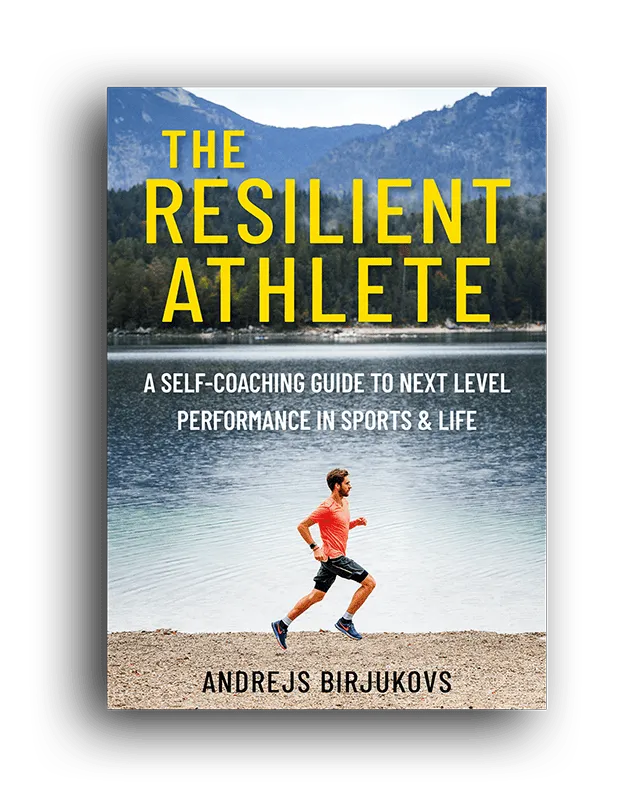
The Resilient Athlete
A Self-Coaching Guide to Next Level Performance in Sports & Life
Are you aiming to become a resilient athlete who is able to withstand any pressure? Be able to jump on any opportunity? Take any challenge life throws at you head on?
Then this book is for you.
Learn moreEndurance race nutrition – energy needs
Our bodies are like cars – they need fuel to perform. The faster you go, the more fuel you’ll burn. Generally, the body’s preferred source of fuel for intense exercise is carbohydrates, as those can be quickly broken down into energy.
The body always stores a reserve of carbohydrates (known as glycogen) which is enough for ~2 hours of intense exercise. The lower the intensity and the better the fat adaptation of an athlete the longer that reserve can be used for.
For longer races (2 hours and above) athletes need to consume additional carbohydrates in the form of simple carbs (sugars) that are easily digestable – sport drinks, bars, gels, etc. This will help them to maintain the blood sugar and energy levels and maintain the effort for longer.
We can’t replace all calories used during a race, though. Due to the fact that the blood is used for exercising, the stomach cannot process all food ingested. The more intense and stressful the activity, the less the body can absorb, which is why there are different endurance race nutrition strategies for every duration.
Energy from sport drinks
Sport drinks typically are a combination of water, electrolytes/salt and carbs. Sodium & carbohydrates in the drink provide quick energy and hydration, as well as assist in fluid absorption. The flavor profile often promotes drinking more, which reduces the risk of dehydration.
Depending on the proportion of carbs & salt the purpose of the drink differs.
The most optimal way to hydrate during intense training and racing is by consuming isotonic drinks. The concentration of carbs in such drinks is between 6 and 8%, which is enough to provide energy & hydration, yet avoid putting too much stress on the stomach.
Generally, the higher the content of carbs the more water will be taken out of the muscle cells and moved to the stomach to aid in digestion. If that happens during a race athlete can feel premature fatigue and develop gastrointestinal (GI) issues. Which is exactly what happened to me during my first Ironman triathlon.
| Carb content | Salt content | Purpose | |
| Hypotonic | 1% – 5% | high | Quickly replace fluids |
| Isotonic | 6% – 8% | medium | Hydrate & fuel during exercise |
| Hypertonic | 9% – 12% | low | Recover & replace glycogen |
Other types of sports drinks are not that effective for longer racing. Hypotonic drinks are generally used to replenish electrolytes and help to move the water into dehydrated muscle cells. Hypertonic drinks, on the other hand, are designed to replenish glycogen and should be used during recovery.
If you prefer Cola or natural fruit juice as a hydration option, make sure you dilute it with water. The carb content in Cola & fruit juice is much higher (around 12%) and that can lead to stomach discomfort during competition or high intensity exercise.
This is exactly why Cola and fruit juice are mixed with water when offered in the aid stations. Not to save money.
Energy from solid foods
Solid foods – like energy bars, fresh & dried fruits, bread, rice cakes, nuts, etc. – are great sources of energy. On top of that these foods typically contain some fats and protein in addition to carbs which provides a feeling of fulness and breaks that sugary taste.
However, the body needs more time to break down such foods to use them for energy. Which is why it’s best not to consume those during high-intensity races or in sports with high impact on the body (like running).
Solid foods are great sources of fuel during long bike rides, kayak and adventure races (like my overnight kayak marathon), hiking & trekking trips and so on. Not so much during a marathon.
Energy from gels
For higher intensity sports & competitions gels are a much better alternative to solid foods.
Gels are highly concentrated substances containing primarily carbs. It’s an efficient way of taking in energy, because the body doesn’t need to spend extra effort breaking down the food.
Most gel packets contain roughly 25 grams of carbs, which is generally enough for 30-40 minutes of exercise. However, gels have to be consumed with plenty of water, because they contain a high concentration of carbs – otherwise they will cause an upset stomach. The idea is the same as with isotonic drinks. Aim for a 6-8% concentration of carbs to liquid.
So, a gel with ~25 grams of carbs will require at least 300ml of water to get well-processed.
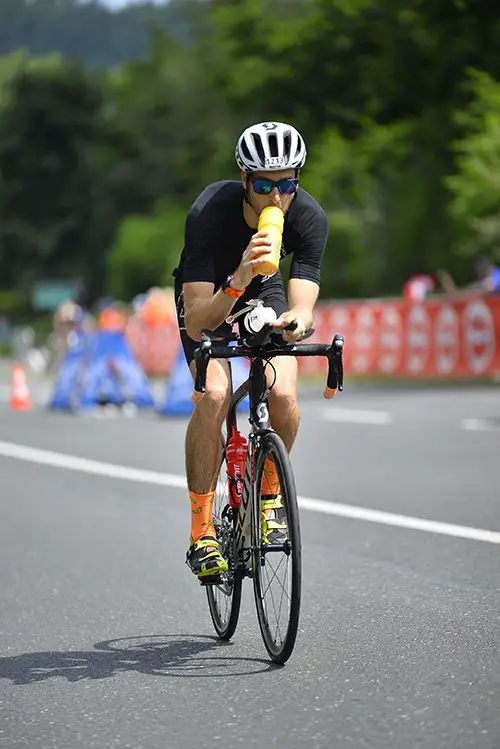
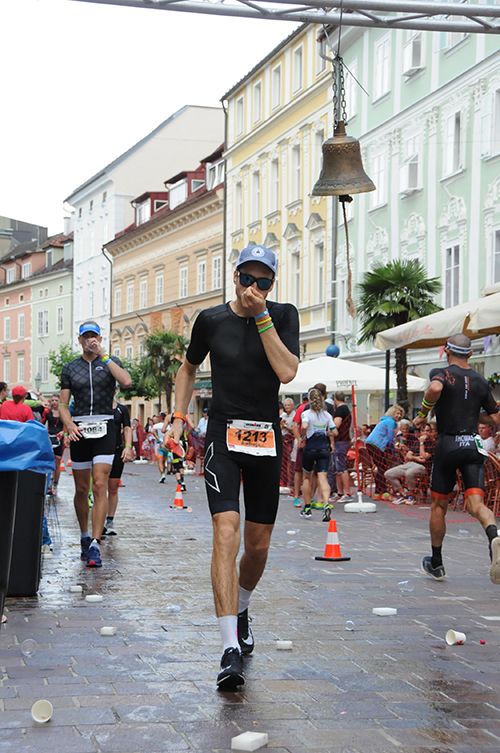
Endurance race nutrition – other
While carbs are the main source of energy, there are other nutrients that play an important role and impact how the body performs.
Protein
Consuming a little protein during endurance events helps to slow down the muscle breakdown process, which helps to stay stronger for longer.
Overall the carb-to-protein ratio between 12:1 and 15:1 is optimal to minimize the muscle breakdown. Too much protein during exercise can result in gassy feeling and contribute to fatigue.
An absolute minimum carb-to-protein ratio is 4:1. But that should be used only in longer-distance races that don’t have a high impact on the body, like the Ironman bike leg, for example.
Fat
Even though endurance sport is mostly fueled by fat, relying on it to fuel the race is not the best strategy. Fat is quite heavy and very difficult for the body to process. Consuming large quantities of it will force the stomach to work harder and take away the energy from the race.
Fiber
Fiber is another element to watch out for during a competition.
In training it’s very healthy. Foods rich in fiber typically contain lots of vitamins & minerals that help you recover faster. Fiber is also quite satiating, which helps to not over-eat and maintain a healthy weight.
However, for the competition it’s better to minimize fiber consumption – both before and during. Besides being harder to process and causing bloating, one of the effects of fiber is that it promotes bowel movements and stimulates the need to go to the toilet.
If you like bananas, dates or other fruits & berries, try to combine them with plenty of water and other sources of energy that have less fiber in them, like iso drinks, gels, bars.
Caffeine
There are many studies that have found a positive effect of consuming caffeine on endurance performance.
For most of the athletes, as little as 75-100mg of caffeine can provide both a mental and physical boost. Caffeine is absorbed within ~20 minutes of ingestion and reaches it’s peak blood concentration within an hour or so. So, it can be consumed before or during the competition.
It’s worh remembering, though, that one of the side effects of caffeine is that it stimulates fluid loss. Athletes might require more fluids than usual to outweight the effect of caffeine. The best approach is to test the effect first and decide whether to use it or not.
During Berlin marathon, I found caffeine to be a great way to keep the heart rate high and avoid fading in the end of the race.
Related: How To Become A Better Athlete – 38 Practical & Useful Tips
Endurance race nutrition strategies
Whichever endurance race nutrition plan you create, remember to practice it in training. Determine what’s your sweat rate. Test what kind of nutrition works well with your body and intensity. Check if you are able to carry it. Is it gels or a mix of energy bars and isodrink? If so, how many and at what time?
Just as athletes train their bodies to be in top form for the race, they must practice nutrition prior to the competition as well.
A race simulation session is the best opportunity for these kinds of tests. It provides similar intensity, duration or environment to make conclusions and necessary changes.
Sub-30 minutes
Any race under 30 minutes doesn’t require any nutrition. Carbohydrates would take anywhere from 10 to 20 minutes to absorb, so there won’t be enough time to utilize them anyway.
30 minutes is also not enough time to get too dehydrated, so many athletes (especially those on the track) don’t even consume water.
Race examples: Elite 10K, average 5K.
30 to 90 minutes
At this point the intensity is still very high – slightly over or under the threshold effort. There’s a high chance the stomach will not be able to process a large dose of carbs fully.
Those who run a ~90-minute race and want a small extra kick can take a gel (25g of carbs) with caffeine at around 60 minutes in.
The body doesn’t need nutrition for this duration, actually. Glycogen in the muscles is enough for ~2 hours of hard exercise, so athletes should not be concerned with running out of energy. It’s much more important to remain well-hydrated.
Poor hydration (not enough water, sodium or other electrolytes) can become a real factor towards the end of the race and cause premature fatigue. Hypotonic drinks are best at mitigating that and providing required fluids & electrolytes.
Race examples: slower 10K, faster half marathon.
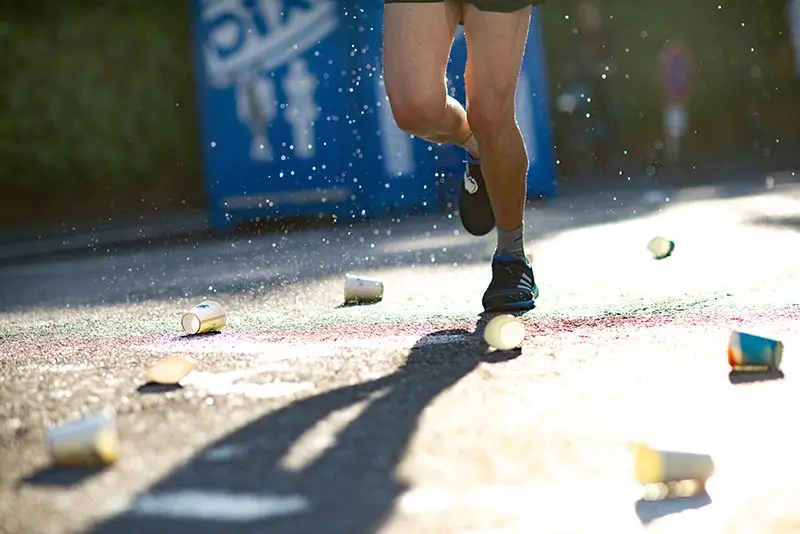
90 minutes to 4 hours
That premature fatigue caused by lack of sodium and other electrolytes in the body can multiply as the race gets longer. Once the race duration gets past 2 hours it’s very important to pace yourself correctly, sip water consistently and take extra nutrition at even intervals.
Depending on the sport and race distance/duration it’s good to aim somewhere between 30g and 45g of carbs per hour. Running is a high impact sport so it’s best to stay on the lower end and in a form of isotonic drinks & energy gels. Bike rides and intense trekking are less impactful, so nutrition can be closer to 45g and can be in the form of solid foods as well.
For instance, for a 3-hour marathon an athlete can aim for 4 gels each taken every 40 minutes (besides water). For a fast half Ironman it can be a couple of energy bars on the bike and 2 gels on the run all together with isotonic drink and water.
Race examples: slower half marathon, faster marathon, olympic-distance triathlon, fast half Ironman triathlon.
4+ hours
As the race distance increases the intensity decreases. On the shorter end (4-5 hours) the large portion of the race is still a Zone 3 effort, so athletes should target 45g of carbs per hour. On a longer end (full Ironman) the intensity is almost completely in Zone 2 and athletes should aim for 50g to 60g grams of carbs per hour.
Related: Train Smart – Practical Guide to 5 Exercise Heart Rate Zones
There are some studies that discuss that in Zones 2 and 3 the body can absorb up to 90 grams of carbs per hour if it’s sourced from multiple sources – i.e. fructose, sucrose, etc. However, there’s a high chance of GI distress, so try it out in training first.
Race examples: ultra marathon, half & full Ironman triathlon
Did you find this information useful? Share the post with others using the buttons below.
Have an opinion? Share via links below and tag @theathleteblog
Tags In
Andrejs Birjukovs
GET A FREE TRAINING PLAN
Subscribe to my email list and get access to a free 4-week “back in shape” training plan
You’ll also get two full-body strength sessions and some other goodies!
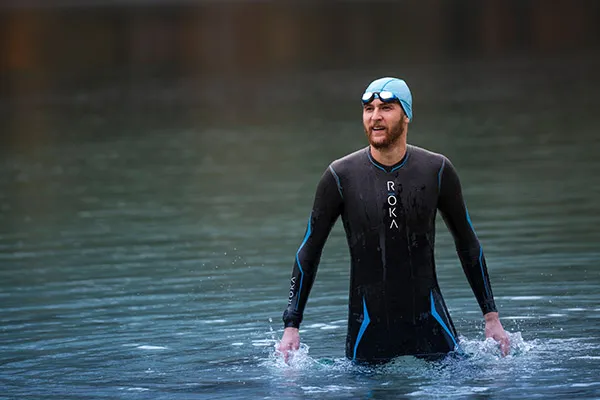
How did I get here?
Hey there! My name is Andrejs and I am here to inspire, entertain and get you fit for any adventure.
I went from being an over trained pro athlete to an endurance coach sharing how to listen to your body and live life to the fullest.
Traveling, new sports & activities brought new meaning to my training and made it much more effective, fun and enjoyable. And I'm here to help you do the same.

